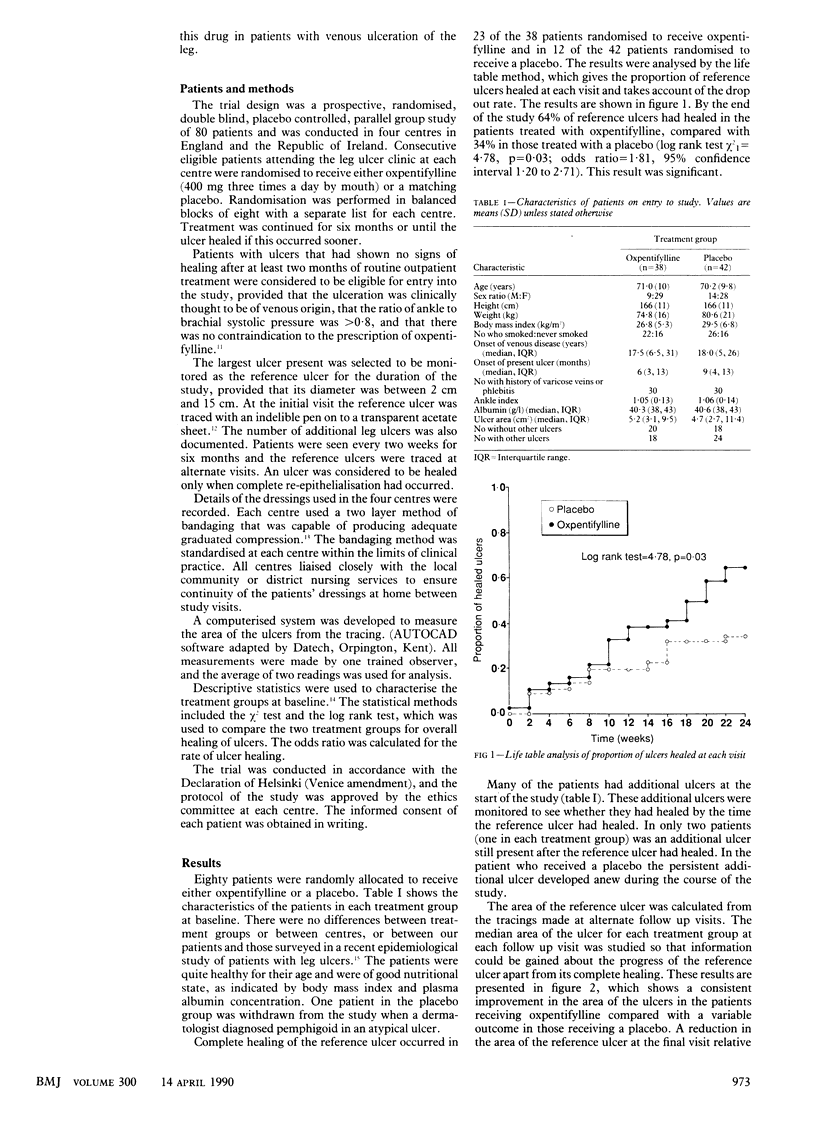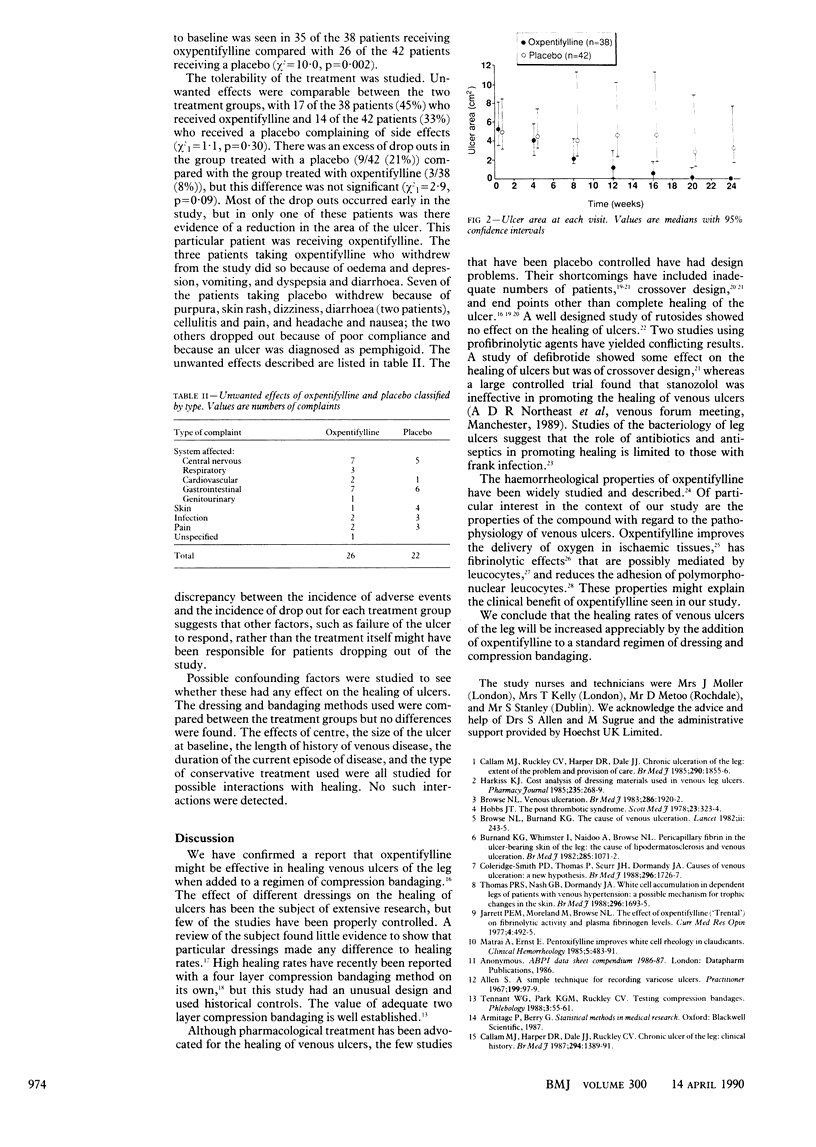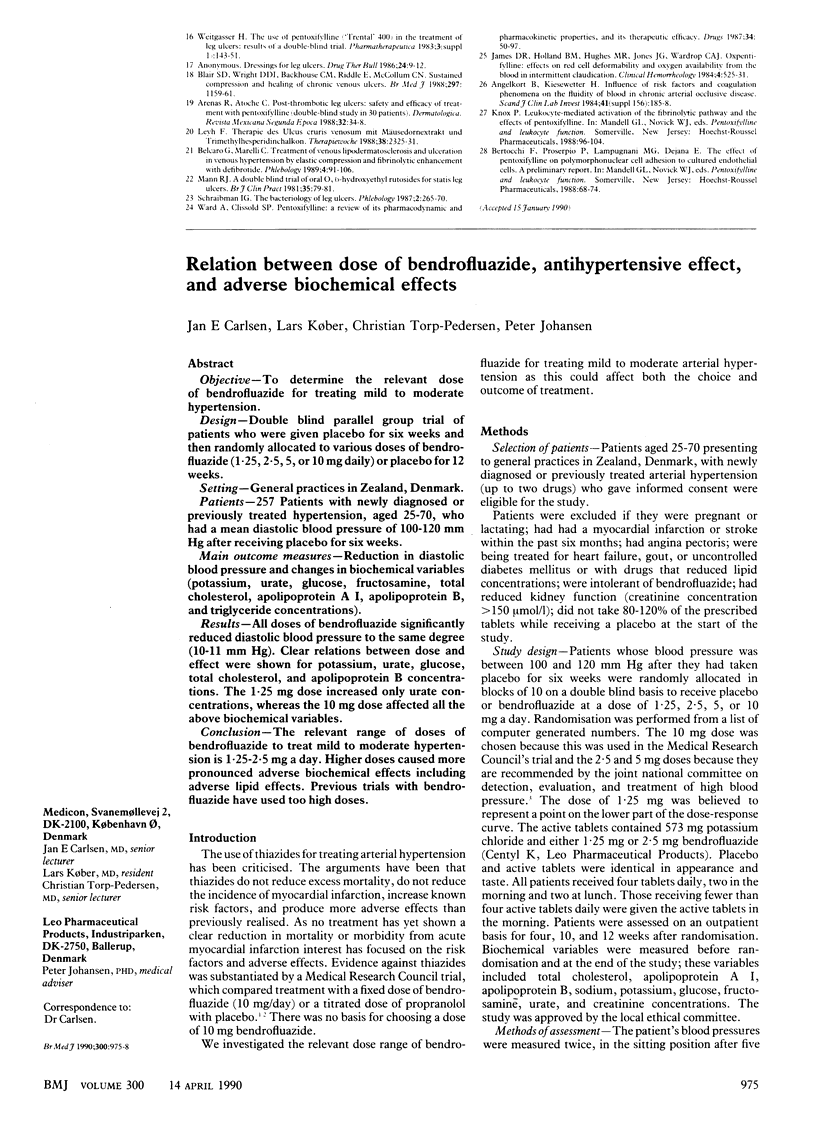Abstract
OBJECTIVE--To determine the effect of oxpentifylline on the healing of venous ulcers of the leg. DESIGN--Double blind, randomised, prospective, placebo controlled, parallel group study. SETTING--Four outpatient clinics treating leg ulcers in England and the Republic of Ireland. PATIENTS--80 Consecutive patients with clinical evidence of venous ulceration of the leg in whom appreciable arterial disease was excluded by the ratio of ankle to brachial systolic pressure being greater than 0.8. INTERVENTIONS--All patients received either oxpentifylline 400 mg three times a day by mouth or a matching placebo for six months (or until their reference ulcer healed if this occurred sooner) in addition to a locally standardised method of compression bandaging. MAIN OUTCOME MEASURES--The primary end point was complete healing of the reference ulcer within six months. The secondary end point was the change in the area of the ulcer over the six month observation period. RESULTS--Complete healing of the reference ulcer occurred in 23 of the 38 patients treated with oxpentifylline and in 12 of the 42 patients treated with a placebo. Life table analysis showed that the proportion of ulcers healed at six months was 64% in the group treated with oxpentifylline compared with 34% in the group treated with a placebo (log rank test chi 2 = 4.78, p = 0.03), which was significant (odds ratio = 1.81, 95% confidence interval 1.20 to 2.71). CONCLUSION--Oxpentifylline used in conjunction with compression bandaging improves the healing of venous ulcers of the leg.
Full text
PDF



Selected References
These references are in PubMed. This may not be the complete list of references from this article.
- Allen S. A simple technique for recording varicose ulcers. Practitioner. 1967 Jul;199(189):97–99. [PubMed] [Google Scholar]
- Angelkort B., Kiesewetter H. Influence of risk factors and coagulation phenomena on the fluidity of blood in chronic arterial occlusive disease. Scand J Clin Lab Invest Suppl. 1981;156:185–188. doi: 10.3109/00365518109097457. [DOI] [PubMed] [Google Scholar]
- Blair S. D., Wright D. D., Backhouse C. M., Riddle E., McCollum C. N. Sustained compression and healing of chronic venous ulcers. BMJ. 1988 Nov 5;297(6657):1159–1161. doi: 10.1136/bmj.297.6657.1159. [DOI] [PMC free article] [PubMed] [Google Scholar]
- Browse N. L., Burnand K. G. The cause of venous ulceration. Lancet. 1982 Jul 31;2(8292):243–245. doi: 10.1016/s0140-6736(82)90325-7. [DOI] [PubMed] [Google Scholar]
- Browse N. L. Venous ulceration. Br Med J (Clin Res Ed) 1983 Jun 18;286(6382):1920–1922. doi: 10.1136/bmj.286.6382.1920. [DOI] [PMC free article] [PubMed] [Google Scholar]
- Burnand K. G., Whimster I., Naidoo A., Browse N. L. Pericapillary fibrin in the ulcer-bearing skin of the leg: the cause of lipodermatosclerosis and venous ulceration. Br Med J (Clin Res Ed) 1982 Oct 16;285(6348):1071–1072. doi: 10.1136/bmj.285.6348.1071. [DOI] [PMC free article] [PubMed] [Google Scholar]
- Callam M. J., Harper D. R., Dale J. J., Ruckley C. V. Chronic ulcer of the leg: clinical history. Br Med J (Clin Res Ed) 1987 May 30;294(6584):1389–1391. doi: 10.1136/bmj.294.6584.1389. [DOI] [PMC free article] [PubMed] [Google Scholar]
- Callam M. J., Ruckley C. V., Harper D. R., Dale J. J. Chronic ulceration of the leg: extent of the problem and provision of care. Br Med J (Clin Res Ed) 1985 Jun 22;290(6485):1855–1856. doi: 10.1136/bmj.290.6485.1855. [DOI] [PMC free article] [PubMed] [Google Scholar]
- Coleridge Smith P. D., Thomas P., Scurr J. H., Dormandy J. A. Causes of venous ulceration: a new hypothesis. Br Med J (Clin Res Ed) 1988 Jun 18;296(6638):1726–1727. doi: 10.1136/bmj.296.6638.1726. [DOI] [PMC free article] [PubMed] [Google Scholar]
- Hobbs J. T. The post thrombotic syndrome. Scott Med J. 1978 Oct;23(4):323–324. doi: 10.1177/003693307802300418. [DOI] [PubMed] [Google Scholar]
- Jarret P. E., Moreland M., Browse N. L. The effect of oxpentifylline ('Trental') on fibrinolytic activity and plasma fibrinogen levels. Curr Med Res Opin. 1977;4(7):492–495. doi: 10.1185/03007997709109338. [DOI] [PubMed] [Google Scholar]
- Mann R. J. A double blind trial of oral O. B-hydroxyethyl rutosides for stasis leg ulcers. Br J Clin Pract. 1981 Feb;35(2):79–81. [PubMed] [Google Scholar]
- Thomas P. R., Nash G. B., Dormandy J. A. White cell accumulation in dependent legs of patients with venous hypertension: a possible mechanism for trophic changes in the skin. Br Med J (Clin Res Ed) 1988 Jun 18;296(6638):1693–1695. doi: 10.1136/bmj.296.6638.1693. [DOI] [PMC free article] [PubMed] [Google Scholar]


